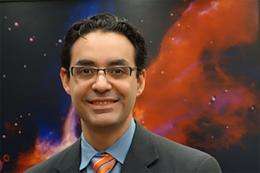Physicist explains how new results from an underground experiment add intrigue to the hunt for dark matter

Physicists operating an underground experiment in Minnesota reported last week that they have found possible hints of dark matter. The Cryogenic Dark Matter Search (CDMS) experiment detected three events with the characteristics expected of dark matter, Kevin McCarthy, a PhD student in physics at MIT, reported at the American Physical Society meeting in Denver.
These results do not meet the criteria physicists use to claim a discovery, so CDMS scientists now plan to conduct more analysis. One of those scientists, Enectali Figueroa-Feliciano, an associate professor of physics at MIT and McCarthy's adviser, spoke with MIT News about the new results.
Q: What are the implications of this result? Why should non-physicists care about this?
A: We are trying to answer a very simple question: What is the universe made of? The strange picture that has emerged over the last two decades is one where over 84 percent of the matter in the universe is not in the atoms that make up stars or planets or rocks or dust or gas, but in a new substance that we call dark matter.
We currently think dark matter consists of a yet-to-be-discovered fundamental particle that permeates all of space. If this is the right picture, millions of these particles go through our bodies every second. Scientists have been trying to see interactions between dark matter and "normal" matter—the detectors at our underground experiment.
If such interactions are found, they would carry the imprints of the properties of the dark-matter particle, information that would help us open a new window of understanding into the most fundamental properties of our universe at both the subatomic and cosmological scales.
Q: What was MIT's contribution to this finding?
A: The CDMS collaboration is composed of 18 institutions; running the experiment, taking the data, and analyzing it is a group effort. A significant portion of this analysis, however, was carried out by Kevin McCarthy as part of his PhD thesis at MIT. The analysis of a potential dark-matter interpretation of the data was done by MIT postdoctoral researcher Julien Billard.
Q: What is the next step for this research?
A: Our results are intriguing, but not enough for a definitive discovery. To really determine the source of these events, we are doing further analysis on this data, and are taking new data right now in our experiment half a mile underground in an old iron mine in the town of Soudan, Minn. Other dark-matter experiments are also exploring this region of interest. It will take several experiments, seeing consistent signals, in order to definitively solve the dark-matter riddle.
Provided by Massachusetts Institute of Technology
This story is republished courtesy of MIT News (web.mit.edu/newsoffice/), a popular site that covers news about MIT research, innovation and teaching.



















